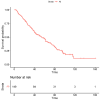Ultrasound Patterns of Hepatocellular Carcinoma and Their Prognostic Impact: A Retrospective Study
- PMID: 38001656
- PMCID: PMC10670191
- DOI: 10.3390/cancers15225396
Ultrasound Patterns of Hepatocellular Carcinoma and Their Prognostic Impact: A Retrospective Study
Abstract
Background: Hepatocellular carcinoma (HCC) is a leading cause of cancer-related death. Abdominal ultrasound (US) is by far the most widely used first-level exam for the diagnosis of HCC. We aimed to assess whether different ultrasound patterns were related to tumor prognosis.
Methods: We retrospectively reviewed all patients with a new diagnosis of HCC (single nodule) and undergoing radiofrequency thermal ablation (RFTA) at our clinic between January 2009 and December 2021. Patients were classified according to four HCC ultrasound patterns: 1A, single capsulated nodule; 1B, well capsulated intra-node nodule; 1C, cluster consisting of capsulated nodules; and 2, non-capsulated nodule.
Results: 149 patients were analysed; median follow-up time was 43 months. US patterns 1A (32.9%) and 1B (61.1%) were the most commonly seen. Median overall survival (OS) and recurrence-free survival (RFS) from RFTA were 54 months (95% CI, 42-66) and 22 months (95% CI, 12-32), respectively. Pattern 1A showed the best OS. Compared to pattern 1A, 1B was independently associated with worse OS (51 months (95% CI, 34-68) vs. 46 months (95% CI, 18-62)) and RFS (34 months (95% CI, 27-41) vs. 18 months (95% CI, 12-24)). Patterns 1C and 2 were associated with worse RFS compared to 1A, while no difference was seen for OS. Among baseline clinical variables, pattern 1B exhibited higher histological grade (p = 0.048) and tumor dimension (p = 0.034) compared to pattern 1A.
Conclusions: Our findings demonstrate that different US patterns correlate with different survival outcomes and tumor behavior in patients with HCC. Prospective studies are needed to confirm these results.
Keywords: abdominal ultrasound; hepatocellular carcinoma; histological grade; overall survival; recurrence-free survival; ultrasound pattern.
Conflict of interest statement
The authors declare no conflict of interest.
Figures




Similar articles
-
Single-nodule hepatitis B virus-associated hepatocellular carcinoma smaller than 3 cm: two phenotypes defined by cluster analysis and their association with the outcome of ablation as the first-line therapy.Int J Hyperthermia. 2021;38(1):120-129. doi: 10.1080/02656736.2021.1876930. Int J Hyperthermia. 2021. PMID: 33541160
-
Prognostic Role of Albumin-Bilirubin Grade in Hepatocellular Carcinoma After Ultrasound-guided Percutaneous Radiofrequency Ablation: A Single-center Experience Over a Decade.Surg Laparosc Endosc Percutan Tech. 2022 Jun 1;32(3):350-356. doi: 10.1097/SLE.0000000000001049. Surg Laparosc Endosc Percutan Tech. 2022. PMID: 35297807
-
Long-term survival of hepatocellular carcinoma after percutaneous radiofrequency ablation guided by ultrasound.World J Surg Oncol. 2017 Jul 5;15(1):122. doi: 10.1186/s12957-017-1189-1. World J Surg Oncol. 2017. PMID: 28679433 Free PMC article.
-
Predictive effects of a combined indicator in patients with hepatocellular carcinoma after thermal ablation.J Cancer Res Ther. 2020 Sep;16(5):1038-1050. doi: 10.4103/jcrt.JCRT_1080_19. J Cancer Res Ther. 2020. PMID: 33004745
-
Risk Factors, Patterns, and Long-Term Survival of Recurrence After Radiofrequency Ablation With or Without Transarterial Chemoembolization for Hepatocellular Carcinoma.Front Oncol. 2021 May 27;11:638428. doi: 10.3389/fonc.2021.638428. eCollection 2021. Front Oncol. 2021. PMID: 34123790 Free PMC article.
Cited by
-
Deep learning based on ultrasound images to predict platinum resistance in patients with epithelial ovarian cancer.Biomed Eng Online. 2025 May 13;24(1):58. doi: 10.1186/s12938-025-01391-8. Biomed Eng Online. 2025. PMID: 40361149 Free PMC article.
-
Small nuclear ribonucleoprotein polypeptide B2 regulated by SNHG4/miR-204-5p axis inhibits ferroptosis to aggravate the progression of hepatocellular carcinoma.Discov Oncol. 2025 Jul 16;16(1):1349. doi: 10.1007/s12672-025-03192-w. Discov Oncol. 2025. PMID: 40670855 Free PMC article.
References
LinkOut - more resources
Full Text Sources

